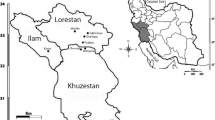Abstract
Persicaria minor is an annual medicinal plant which grows in different regions of Iran. Antioxidative, antimicrobial, antiviral, anti-inflammatory and cytotoxic activities are reported in this plant. No investigation has been reported about population genetic structure of this valuable plant species in Iran. Therefore, genetic analysis of 11 populations of this species was carried out using ISSR markers for the first time. Genetic variability analysis revealed high genetic diversity within populations of this species. AMOVA test produced significant genetic difference among the studied populations. Mantel test revealed significant correlation between genetic distance and geographical distance of the populations. STRUCTURE analysis and K-means clustering showed population genetic fragmentation and the presence of two gene pools for this species. The results suggested that genetic divergence, gene flow and local adaptation have played an important role in diversification of P. minor.



Similar content being viewed by others
References
Ali AM, Mackeen MM, El-Sharkawy SH, Abdul Hamid J, Ismail NH, Ahmad FBH, Lajis NH. Antiviral and cytotoxic activities of some plants used in Malaysian indigenous medicine. Pertanika J Trop Agric Sci. 1996;19:129–36.
Azizi N, Sheidai M, Mozafarian V, Noormohammadi Z. Genetic, cytogenetic and morphological diversity in Helicrysum leucocephalum (Asteraceae) populations. Biologia. 2014;69:566–73.
Baharum SN, Bunawan H, Ghani MA, Mustapha AW, Noor NM. Analysis of the chemical composition of the essential oil of Polygonum minus Huds. Using two-dimensional gas chromatography-time-of-flight mass spectrometry (GC-TOF MS). Molecules. 2010;15:7006–15.
Bazzaz FA. Life history of colonizing plants: some demographic, genetic, and physiological features. In: Mooney HA, Drake JA, editors. Ecology of biological invasions of North America and Hawaii. 58. Ecological studies. New York: Springer; 1986. p. 97–110.
Çalişkan M. Genetic Diversity in Plants Publisher: In: Tech, Chapters published under CC BY 3.0 license; 2012.
Choudhary RK, Ali MA, Lee J. Studies on genetic diversity among populations of Persicaria barbata (L.) H. Hara from India based on internal transcribed spacer sequences of nuclear ribosomal DNA. Saudi J Biol Sci. 2011;18:123–7.
Christapher PV, Parasuraman S, Christina JMK, Asmawi MZ, Vikneswaran M. Review on Polygonum minus. Huds, a commonly used food additive in Southeast Asia. Pharmacognosy Res. 2015;7:1–6.
DeWalt SJ, Hamrick JL. Genetic variation of introduced Hawaiian and Native Costa Rican populations of an invasive Tropical shrub, Clidemia hirta (Melastomataceae). Am J Bot. 2004;91:1155–62.
Ee SF, Mohamed-Hussein ZA, Othman R, Shaharuddin NA, Ismail I, Zainal1 Z. Functional characterization of Sesquiterpene synthase from polygonum minus. Sci World J. 2014;2014:1–11.
Ee SF, Oh JM, Noor NM, Known TR, Mohamed-Hussein ZA, Ismail I, Zainal Z. Transcriptome profiling of genes induced by salicylic acid and methyl jasmonate in Polygonum minus. Mol Biol Rep. 2013;41:2231–41.
Ellis JR, Burke JM. EST-SSRs as a resource for population genetic analyses. Heredity. 2007;99:125–32.
Evanno G, Regnaut S, Goudet J. Detecting the number of clusters of individuals using the software STRUCTURE: a simulation study. Mol Ecol. 2005;14:2611–20.
Freeland JR, Kirk H, Peterson SD. Molecular ecology. 2nd ed. London: Wiley-Blackwell; 2011.
Frichot E, Schoville SD, Bouchard G, Francois O. Testing for associations between loci and environmental gradients using latent factor mixed models. Mol Biol Evol. 2013;30:1687–99.
Griffith TM, Sultan SE. Plastic and constant developmental traits contribute to adaptive differences in co-occurring Polygonum species. Oikos. 2006;114:5–14.
Hamer Ø, Harper D, Ryan PD. PAST: paleontological statistics software package for education and data analysis. Palaeontol Electron. 2012;4:9.
Hedrick PW. A standardized genetic differentiation measure. Evolution. 2005;59:1633–8.
Heschel MS, Sultan SE, Glover S, Sloan D. Population differentiation and plastic responses to drought stress in the generalist annual Polygonum persicaria. Int J Plant Sci. 2004;165:817–24.
Holsinger KE, Lewis PO. Hickory: a package for analysis of population genetic data V1.0. 2003. http://www.eeb.uconn.edu.
Jost L. GST and its relatives do not measure differentiation. Mol Ecol. 2008;17:4015–26.
Matesanz S, Horgan-Kobelski T, Sultan SE. Phenotypic plasticity and population differentiation in an ongoing species invasion. PLoS ONE. 2012;12:e44955.
Matesanz S, Theiss KE, Holsinger KE, Sultan SE. Genetic diversity and population structure in Polygonum cespitosum: insights to an ongoing plant invasion. PLoS ONE. 2014;9:93217.
Meirmans PG. AMOVA-based clustering of population genetic data. J Hered. 2012;103:744–50.
Peakall R, Smouse PE. GENALEX 6: genetic analysis in Excel. Population genetic software for teaching and research. Mol Ecol Notes. 2006;6:288–95.
Podani J. Introduction to the exploration of multivariate data [English translation], Leide. Netherlands: Backhuyes; 2000.
Pritchard JK, Stephens M, Donnelly P. Inference of population structure using multilocus genotype data. Genetics. 2000;155:945–59.
Qader SW, Abdulla MA, Lee SC, Hamdan S. Potential bioactive property of Polygonum minus Huds (kesum) review. Sci Res Essays. 2012;7:90–3.
Sheidai M, Zanganeh S, Haji-Ramezanali R, Nouroozi M, Noormohammadi Z, Ghsemzadeh-Baraki S. Genetic diversity and population structure in four Cirsium (Asteraceae) species. Biologia. 2013;68:384–97.
Sigrist MS, Carvalho CJB. Detection of areas of endemism on two spatial scales using Parsimony Analysis of Endemicity (PAE). Biota Neotrop. 2008;8:33–42.
Sultan SE. Phenotypic plasticity in plants: a case study in ecological development. Evol Dev. 2003;5:25–33.
Weising K, Nybom H, Wolff K, Kahl G. DNA fingerprinting in plants: Principles, methods, and applications. 2nd ed. Boca Rayton: CRC Press; 2005.
Wiart C. Medicinal plants of Asia and the Pacific. Boca Rayton: CRC Press; 2006.
Acknowledgments
This research was supported by Grant provided by Shahid Beheshti University.
Author information
Authors and Affiliations
Corresponding author
Rights and permissions
About this article
Cite this article
Sheidai, M., Mosaferi, S., Keshavarzi, M. et al. Genetic diversity in different populations of Persicaria minor (Polygonaceae), a medicinal plant. Nucleus 59, 115–121 (2016). https://doi.org/10.1007/s13237-016-0169-0
Received:
Published:
Issue Date:
DOI: https://doi.org/10.1007/s13237-016-0169-0




